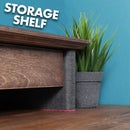Introduction: The Polka Dot Keepsake Box
This keepsake box was a gift for my girlfriend. I made it for her as a Christmas present as she loves all things Polka Dot. The box construction is very simple and the hardware is very easy to fit. The polka dots are made by drilling holes and filling with epoxy putty. Let's get into it! Here is the video of how I made it if you're interested:
Supplies
Step 1: Cut Sides to the Box
The Padauk I bought for this project was rough sawn and quite a bit thicker than I needed it to be so I used my thickness planer to plane it smooth and to about 20mm thick. The board was 150mm wide, I wanted it to to be 125mm wide though. This will make the depth of the finished box 125mm. I first trimmed a thin piece off on my table saw. Then I could move the fence to 125mm and cut the board to size.
While the board is still in one long length it will be easier to route the grooves to recieve the top and bottom to the box later. I made the grooves on the router table using a straight bit. The grooves were roughly 8mm deep by 10mm wide. Once the grooves are cut its time to cut the board to length. I did this with a sliding mitre saw that can tilt to 45 degrees. This will create the mitre joints to the box corners.
I want the overall size of the box to 30cm x 20cm. So I cut 2 pieces to 30cm long and 2 pieces to 20cm long. I cut them in series so the grain follows all the way round the side of the box. I like to add letter labels (Part A, B, C...) so I can keep track of the order they go together. Cutting mitres can get confusing at times so always double check you're cutting the right side and make sure the mitre is cutting in the right direction. Little sanity checks save a lot of headache in the long run.
Step 2: Glue Up the Sides of the Box
Painters tape is a great way to clamp mitre joints on boxes. I lay the pieces out in series (A, B, C...) then flip them over so the mitre joints are face down (Inside of the box). I then added strips of painters tape across each joint. I could then flip them back over and add wood glue to the joint.
With glue in every joint the pieces simply roll up to form the box. Some extra painters tape holds it all in place while the glue dries. Its a good idea to double check the corners are square now while you still have some wiggle room. I did notice my corners didn't quiet come together tight. A little glue and sawdust mixed to a putty soon filled the gaps though and they aren't noticeable.
Step 3: Add the Top & Bottom
While the glue's drying on the box I turned my attention to the top and bottom pieces. I used the bandsaw to resaw some Padauk and Maple. I cut these to about 10mm thick and then planed them smooth to roughly 8mm thick. The maple is for the bottom and is good as is. The Padauk needed a little more work though.
I loved the grain pattern of the Padauk so I glued 2 pieces together to create a book match grain effect. Both the Padauk and Maple pieces then got cut to size at the bandsaw so they fit snug in the top and bottom of the box.
Wood glue added around the edge of the grooves in the top and bottom is all that's need to secure the Padauk and Maple in place. Clamps hold them tight down while the glue dries. Once the glue was dry I sanded the box all over.
Step 4: Create the Polka Dots
The box is called The Polka Dot Box so we need to add the polka dots now. I did this by laying out a pattern all over the box apart from the bottom. Then using a 6mm drill bit I drilled the holes 3mm deep. These holes will be the polka dots.
To fill the holes and turn them into white polka dots I used White Milliput Epoxy Putty. This gets mixed together in equal quantities and when its set its rock solid. I filled all the holes and left it to set over night.
The dots obviously don't look great at this point. Now they're dry they are easily sanded flush. Revealing the perfect circles cut with the drill bit. A card scraper works great too.
Step 5: Cut the Lid Free
You're probably wondering where the lid to the box comes from? Well the next step is to cut the lid free from the box. I used the table saw to do this. With the blade raised roughly 30mm high I cut through each side. Its best to start the cuts on a short side of the box so the last cut is made on a long side. It's more stable doing it this way. With the lid cut off I sanded the cut edges smooth and flat.
Step 6: Fit the Hinges
It's time to look at hardware. I went with rail hinges for this project. I think they're the best looking options for boxes.
To fit these style hinges is really simple. I used my router table, a stop block and 6mm straight spiral bit. You can use a standard straight bit too though. I made test cuts on some scrap plywood first. Made sure the fit was perfect first. When I was happy with the fit in the scrap plywood I made the cuts on the box and lid itself. The cuts are made on both sides of the box and lid. The rail hinges should sit flush with no gaps around the edges. Such a clean look.
Now its time to add the finish. I went with gloss spray lacquer. It dries really quick and really makes the grain and colour pop. I applies 3 coats all over the box and lid. Inside and out. I sanded between each coat to give a smooth finish.
Now the hinges can fitted. I used the included screws. I did drill pilot holes first to try to prevent the screws from splitting the wood and to prevent the heads from snapping off.
Step 7: Fit the Push Button Latch
I used a push button latch for the box. I think it goes great with the polka dot design on the box. This uses a locking pin and a sprung button to capture the pin in place. When you press the button is releases the pin and unlocks the box.
Fitting the locking pin requires a hole to be drilled in the centre of the lid. It gets held in place with super glue. I used the gel kind. The pin gets pushed in place and left for the glue to set.
Using the pin to mark where it touches on the box will give a guide to drill the holes for the latch itself. Fitting the latch requires a hole drilled down through the wall of the box to receive the locking pin. It also needs a larger hole drilled through the front to meet that hole. The latch gets held in place with super glue too.
Once the glue is set the box is done!
Step 8: Done!
I really hope you liked this project and give it a go for yourself! I also have a video that is more suited to showcasing the project rather than a how to if you're interested:













